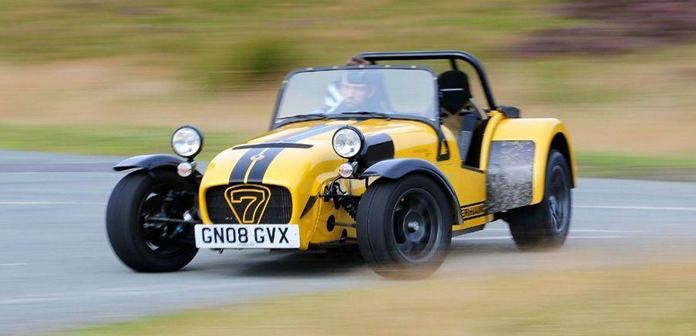The rights to the old Lotus Seven, which became a Super Seven with bigger everythings, were sold to Caterham in 1973. Since then, Caterham was bought by Malaysian interests who had representation in F1. Despite bailiffs and bad press, the Caterham Sevens continue as the cheapest and simplest sub-4 second zero to 100 kph road car you can buy (once you have worked out how to side-step Customs)!

Caterham make many variants, some with a narrow chassis (as per the Chapman original) and others based on a wider chassis for larger people. Almost all the Caterhams have a steel spaceframe covered with stressed aluminium body.
The original Sevens had a live rear axle, but these days, a de Dion rear axle is the norm.
Many different engines have been employed, after Caterham started the process of phasing out the Rover k-series engine and replacing them with Ford engines; the Sigma engine for Roadsports and the 2.0 liter and 2.3 liter Duratec engines for the more powerful Superlight and CSR ranges.
Caterham have had something of a tentative relationship with the installation of motorbike engines into their cars. Since 2000, a Canadian firm has been selling Caterham 7 models using the GSXR1300 engine used in the Suzuki Hayabusa. It reportedly does 0-62 in under 3 seconds. In 2000 the Honda CBR1100 engine was installed into a 430 kg (948 lb) superlight chassis to create the Caterham Blackbird, delivering 170 bhp (127 kW) at 10,750 rpm (although just 92 lb·ft (125 Nm) of maximum torque). The Blackbird offered near R500 performance for rather less money (Top Gear quote 0-60 of 3.7 seconds and a top speed of 143 mph (230 km/h) at a new cost of £25,750). In 2001 a Honda Fireblade engine was offered in a live-axle chassis, via James Whiting of Ashford, Middlesex. Quoted power was 128 bhp (95 kW) at 10,500 rpm. Both of these models have ceased production. There has also been at least one installation of the RST-V8, created by Moto Power; a 2-liter, 40 valve 340 bhp (254 kW) V8 made from a pair of motorcycle engines joined at the crank. An early, pre-production review of the car/engine combination exists on the EVO website. In Feb 2008, the “Caterham 7 Levante” was announced, featuring a supercharged version the RST-V8, offering over 500 bhp (370 kW), installed in a modified Caterham chassis, with bespoke bodywork. Made by RS Performance (described in the press release as “Caterham’s new performance arm”), the Levante is intended to be a limited run of 8 cars at a cost of £115,000 each
The Caterhams are built up in the company’s factory in Dartford, Kent in the UK, while suspension parts that are directly related to an open-wheel race car adorn each end. Engines currently range from a 100 kW Ford 1.6 liter engine from a Fiesta, right through to a performance 177 kW 2.0 liter Duratec unit nicked from the Ford Focus.




